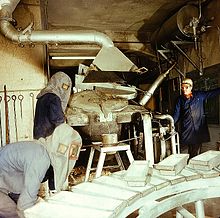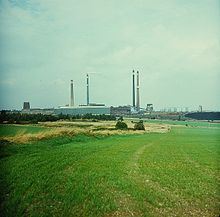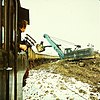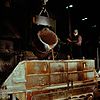Mining and smelting combine "Albert Funk" Freiberg

The VEB Bergbau- und Hüttenkombinat "Albert Funk" Freiberg (abbr. VEB BHKF ) was a large enterprise of the GDR for the extraction and processing of non-ferrous and precious metal raw materials in the organizational form of a combine . It was founded on January 1, 1961, had its headquarters in Freiberg , was divided into several sub-operations and existed until it was privatized in 1990.
Surname
The company name represents the claim to place a comprehensive complex of ore smelting and metal processing under one management.
The name addition Albert Funk refers to a former member of the Reichstag and KPD functionary.
Economic profile
The purpose of the mining and smelting combine "Albert Funk" was primarily the operation of mines for non-ferrous metal ores and their subsequent smelting.
The focus was on the lead , silver and zinc ores from the Freiberg mining area. The historically significant Freiberg mining area was located between Halsbrücke in the north and Brand-Erbisdorf in the south. As part of the metallurgical industry of the GDR, this was the central location for lead-silver-zinc processing. For this purpose there was a lead smelter, a zinc smelter (fine zinc) part in Muldenhütten and a part for gold and silver separation in Halsbrücke.
Furthermore, the mining operations of the tin ore deposits of the Altenberger Revier and the region around Ehrenfriedersdorf were another focal field of activity of the combine. The processing of the tin ore reached an extent that was important for other Comecon countries beyond the GDR and that had its central iron and steel site in Freiberg. The processing plants in Altenberg and the plants in Ehrenfriedersdorf supplied these with raw concentrates.
Nickel ore mining played a subordinate role at the two Saxon locations around St. Egidien and Aue, as did the processing of ore concentrates from the Mansfeld copper shale area.
After the end of Freiberg mining in 1969, the production profile of the combine changed in favor of precious and non-ferrous metal products as well as special materials. The scope of delivery also included products from the areas of consumer goods, rationalization equipment, building materials , steel strip and abrasives.
The combine was not entrusted with the final extraction of rare metals and the production of pure substances for the electronic industry. The ore concentrates or working residues required for this, however, were delivered to VEB Trace Metals in Freiberg, which was founded in 1957 and does not belong to the combine . A concentrate with economically usable indium content remained from the roasting processes of the zinc blende processing of the Feinzink plant . During the processing of the resulting fly ash , it was enriched with 0.1 to 0.3 percent indium. Furthermore, this metal could be obtained from the manufacturing process of working lead .
For the region of its focus locations, the combine had an important income function and took on the promotion of regional cultural work. At the time of its greatest expansion, around 12,000 people were employed in its area of responsibility.
The combine management had been in the building of the historic St.Johannis Hospital at Chemnitzer Straße 8 since January 1, 1978 , after having it reconstructed beginning in 1977.
prehistory
The practice of smelting ores from the Freiberg mining area developed in the early phase of their mining in the 12th century. Archaeological finds in the city of Freiberg prove simple molds from Tonzeug .
One of the early documentary mentions of ore smelting in the Freiberg region is the Untere Muldener Hütte near Halsbach on the Freiberger Mulde from 1318. August the Strong ordered the first merger of fiscal steelworks in Saxony under a uniform administration in 1710 with the General-Schmelz-Administration . The Muldener Hütte was created in 1825 from two existing ironworks .
In the Freiberg mining area, the mining of lead and zinc ores ended in 1913 (5000 t of ore per year). In the 1930s it was taken up again on a small scale and by the end of the decade it had an annual output of only 2,500 tons. For this purpose, the Sachsenz Bergwerks GmbH was established in 1937 .
After the Second World War , the Freiberg lead works was founded in Muldenhütten in 1945 . This operation was merged with other mining operations in Brand-Erbisdorf and Halsbrücke in 1950 in the VEB lead ore mines "Albert Funk" . As early as 1948, the Soviet military administration had founded VVB (Z) Buntmetall among others with order No. 76 . At that time, the following companies belonged to this industrial complex:
- Tin hut Freiberg
- Lead Industry Freiberg (formerly Jung and Lindig )
- State Saxon smelters and blue paint works Freiberg, with the operating facilities:
- Neck bridge
- Muldenhütten
- Upper scheme
- Aue
- Ascension Treasure Trove Freiberg
- Pit aid neck bridge
- Himmelsfürst treasure trove in Brand-Erbisdorf
- United field treasure trove Ehrenfriedersdorf
- Sadisdorf copper mine in Schmiedeberg
- Zwitterstock Altenberg mine
- Wolframite pit Pechtelsgrün.
In 1951 the active Freiberg lead-zinc mines were merged into VEB Bleierzgruben Freiberg .
When in 1952 a large transformation of the East German economic structures took place, walked out of the VVB (Z) non-ferrous metal , the VVB non-ferrous metal industry produces, whose seat in Freiberg and then in 1953 to Eisleben was located.
In the mid-1950s, the Freiberg mining area achieved an ore output of 300,000 tons per year. The tin ore production in the Eastern Ore Mountains, which was expanded in the 1950s and 60s, reached its technical peak in 1963 when the Altenberg central shaft with new processing plants went into operation. The VEB Hüttenwerk Halsbrücke was combined with the Muldenhütten hut to form the VEB Freiberg Bleiütten in 1956 . With the ordinance on the tasks, rights and obligations of the state-owned enterprises, Kombinate and VVB of March 28, 1973 (Journal of Laws of 1973 No. 15, p. 129) (VEB / VVB-VO) , the VVB's and the Formation of combines. The VVB non-ferrous metal industry was broken up into new operational structures between 1967 and 1968, which later resulted in three combines.
Mining and smelting combine "Albert Funk" Freiberg
With the formation of the combine in 1961, existing ore mining operations in Freiberg, Altenberg and Ehrenfriedersdorf were organizationally combined. In the same year, the zinc works in Freiberg started operations.
The VEB tin ore Altenberg came in 1967 in the Combine. He worked in three shafts and had three processing plants. In 1990 this part of the company became the Zinnerz Altenberg GmbH .
In 1968 the combine grew to include another part of the operation, the Sauberg mine ( VEB Zinn- und Spatgruben Ehrenfriedersdorf ). This mining operation formed the sub-area Zinnerz Ehrenfriedersdorf. Until March 28, 1991 ore was mined in the Sauberg district by this combine operation. Then the underground facilities were flooded. The successor company deals with renovation and recycling work in the former development area.
Also in 1968 the combine started the research institute for non-ferrous metals . This institute was founded in 1949 at the instigation of the Soviet Military Administration in Germany (SMAD) in order to conduct the application research required for the GDR industry in the non-ferrous metal and materials processing sector. The institute remained in the structure of the Hüttenkombinat until 1971 and was then transferred to the VEB Mansfeldkombinat Wilhelm Pieck .
The mining of lead and zinc ores in the Freiberg mining area kept the combine up until 1969. As part of ore processing, the combine extracted important trace metals for the needs of microelectronics . After that, until 1990 only tin mining was carried out in Altenberg and Ehrenfriedersdorf and the smelting of foreign non-ferrous metal ores.
When the lead smelting in the ( lead works Hettstedt ) was stopped in 1976 , the combine took over the further processing of the lead-containing residues and the production of lead.
The mining and smelting combine incorporated VEB Nickelhütte St. Egidien from VVB Nichteisenmetalle Eisleben into its area on January 1, 1979 . To the west of Karl-Marx-Stadt they mined and processed silicate nickel ores. Nickel ore mining began in 1952 as VEB Nickelerzgrube Obercallenberg , which was attached to VEB Nickelhütte St. Egidien on September 29, 1953 , and for the first 26 years it ran under changing administrative assignments. Production ended in 1990 when the hut itself was transferred from the combine to Industriegesellschaft St. Egidien mbH . Unnecessary plants were subsequently torn down and the opencast mines recultivated.
The VEB Nickelhütte Aue (since 1966 combine operation) was oriented towards the processing of scrap containing nickel after the research and development center was relocated from Aue to St. Egidien in 1954 .
Between 1980 and 1984, the combine built new facilities in the Muldenhüttener lead works.
The operations in the combine also included the “Einheit” sulfur gravel pit in Elbingerode . The pyrite concentrate delivered from there went to the roasting plant in Muldenhütten, where sulfuric acid was made from it. The mining of iron ore was stopped in August 1990.
gallery
- Motifs for the mining and smelting combine
Day of the Miner and the Energy Worker (Freiberg, July 1980)
Further parts of the company
The complex of the mining and smelting combine also included other companies. Those were:
- VEB rationalization company Freiberg
- VEB Kühlerbau Freiberg,
- VEB semi-finished product plant Auerhammer ,
- VEB Saxon Metal Works,
- Trinks Eisenbau Freiberg,
- Sawmill Bieberstein.
Privatization from 1990
In 1990 the combine was privatized. The complex became part of SAXONIA AG Metallhütten- und Processingwerke Freiberg , which was transformed into Saxonia Standortentwicklungs- und Verwertungs GmbH a short time later . In 1993 the Rheinische Zinkgesellschaft mbH bought the Muldenhütten smelter and formed Muldenhütten Recycling und Umwelt GmbH from it .
Environmental pollution and remedial measures
Freiberg hut
The heavy metal emissions released from the production processes of the combine led to diagnosed health risks, especially in the Freiberg region, which were discussed intensively in the 1980s. These were primarily exposures with significant lead and arsenic levels.
Further additional pollution from cadmium , mercury , copper and zinc has been proven at the Freiberg smelter site. The highly polluted sedimentation basin of the combine on the eastern edge of Freiberg, in operation between 1970 and 1990, was stabilized with an extensive renovation measure and had absorbed around 140,000 cubic meters of neutralization sludge contaminated with heavy metals over its period of use . In addition, the operational dump complex at the same location with 500,000 cubic meters of production waste was given an earth cover to protect against drift and washout, including special insulation layers ( containing bentonite ) and drainage systems. A smaller basin (500 cubic meters) for zinc production was rehabilitated by stabilizing the sedimentation residues, which were mainly contaminated by mercury.
The sewer system of the former industrial sewage disposal system has been exposed to heavy loads since the Freiberg ironworks started operating in 1959, so that leaks and complete functional failure occurred in some areas. The escaping process water caused extensive pollution on the factory premises. The eastern part of the plant is located above historical mining facilities. The infiltration of sludge from the sedimentation basin resulted in an undesirable mobility of pollutants into the Werner-Stolln. Leachate penetrates into the old mining system from this area. It is believed that in the course of dewatering heavy metal content the drainage system of the Rothschönberger Stollns and Royal Society acceptable Stolln-flow to and in this way in the Freiberger trough or same access.
Muldenhütten complex
Extensive renovation and security measures were carried out at the former Muldenhütten plant. The flue gas duct system contained 1,200 tonnes of flue dust , which contained soluble arsenic and heavy metal compounds , dioxin and furan compounds and pesticides . Leachate transported these substances into the surface and groundwater.
Unstable dump slopes and numerous seepage water paths in the area favored the release of pollutants. The processing of tin ore from deposits in the Ore Mountains resulted in a radiological exposure . Contaminated sites from the metallurgical activities of past centuries are also given.
Neck bridge hut area
At the historically significant and already polluted smelter site, processing processes with lead, bismuth , copper vitriol , nickel sulfate , sulfuric acid , silver, gold, palladium and platinum were practiced after 1945 . In the recent history of the company there were galvanic systems for recovery or refinement. Soil pollution is caused by anthropogenic levels of lead, zinc, cadmium, copper and arsenic. Environmental risks lie in polluted seepage water from the company premises and from the associated rinsing and slag heaps in the area. Current assessments assume a relative stability (low tendency to elute ) of the metal compounds in question in the soil. In the mine aid was last operated between 1937 and 1968 mining for lead and zinc ores. Until 1955, flotation residues from the subsequent smelting work were flushed away on a dump at the 7th lighthole of the Rothschönberger Stolln. Oil and paint solvents were then stored here.
Archival documents
In addition to extensive company files, there is a large collection of photos from the combine in the Freiberg mountain archive . It is made up of 24,000 recordings in various forms (paper photos, films, slides). The inventory documents topics of mining and metallurgy in the area of responsibility of the combine and its predecessor institutions from around 1920 to around 1990.
literature
- Horst Kohl: Economic geography of the coal and steel industry in the German Democratic Republic . VEB Hermann Haack publishing house, Geographisch-Kartographische Anstalt. Gotha, Leipzig 1966
- Otfried Wagenbreth : The Freiberg mining . Technical monuments and history. Ed .: Eberhard Wächtler . 2nd Edition. German publishing house for basic industry, Leipzig 1988, ISBN 3-342-00117-8 , p. 381 .
- Research Institute for Non-Ferrous Metals, Freiberg / Sa .; Society of German Miners and Smelters: Metallurgy of Rare Metals and Trace Metals. Lectures at the colloquium on February 20 and 21, 1964 in Freiberg . German publishing house for basic industry, Berlin 1964
Individual evidence
- ↑ a b c d Freiberg mountain archive: VEB Bergbau- und Hüttenkombinat Albert Funk including predecessor companies and successors . at www.archiv.sachsen.de (accessed on May 29, 2020)
- ^ Kohl: Montanindustrie, 1966, p. 144.
- ↑ a b Kohl: Montanindustrie, 1966, pp. 123-124.
- ↑ G. Haake: Investigations into the extraction of indium from lead . In: Metallurgy of rare metals and trace metals. Freiberg 1964, pp. 8-9.
- ^ Wagenbreth, Wächtler, 1985, p. 75.
- ↑ Wagenbreth, Wächtler, 1985, pp. 77-79
- ↑ Thomas von Wagner: About the Chursächsische Bergwerkverfassungs, A contribution to the statistics of Saxony . Leipzig 1787, p. XIV .
- ^ Claudia Thiel: Mirror images of the forgotten and the past - The photo collection of the VEB mining and smelting combine "Albert Funk" Freiberg . In: Sächsisches Archivblatt 2/2002. P. 13-14 ( page no longer available , search in web archives ) Info: The link was automatically marked as defective. Please check the link according to the instructions and then remove this notice. (PDF; 5.6 MB) accessed on July 18, 2010.
- ^ Geo and environmental portal Freiberg , accessed on July 18, 2010.
- ↑ a b c Bergarchiv Freiberg, VVB Buntmetall and Successor ( Memento of the original from February 26, 2014 in the Internet Archive ) Info: The archive link was inserted automatically and has not yet been checked. Please check the original and archive link according to the instructions and then remove this notice. Retrieved July 31, 2010.
- ↑ Freiberg mountain archive : VEB Bergbau- und Hüttenkombinat Albert Funk Freiberg including predecessor companies and successors. Story . on www.archiv.sachsen.de
- ↑ Bergarchiv Freiberg, Hut Halsbrücke ( Memento of the original from February 26, 2014 in the Internet Archive ) Info: The archive link was inserted automatically and has not yet been checked. Please check the original and archive link according to the instructions and then remove this notice. Retrieved July 23, 2010.
- ↑ www.Freiberg-web accessed on July 23, 2010.
- ↑ Bergarchiv Freiberg, VEB Zinnerz Altenberg ( page no longer available , search in web archives ) Info: The link was automatically marked as defective. Please check the link according to the instructions and then remove this notice. Retrieved July 18, 2010.
- ↑ AG abandoned mines, Mountain brotherhood Thum e. V. ( Page no longer available , search in web archives ) Info: The link was automatically marked as defective. Please check the link according to the instructions and then remove this notice. Retrieved July 23, 2010
- ↑ Summary of the 4th Altbergbaukolloquium in Leoben ( Memento of the original from August 8, 2007 in the Internet Archive ) Info: The archive link has been inserted automatically and has not yet been checked. Please check the original and archive link according to the instructions and then remove this notice. Retrieved July 23, 2010.
- ^ Mineralienatlas - time table of Altenberg tin ore mining , accessed on July 18, 2010.
- ↑ Bergarchiv Freiberg, Research Institute for Non-Ferrous Metals Freiberg ( page no longer available , search in web archives ) Info: The link was automatically marked as defective. Please check the link according to the instructions and then remove this notice. Retrieved July 18, 2010.
- ↑ Mansfelder Kupferspuren, Bleihütte Hettstedt ( Memento of the original from February 27, 2016 in the Internet Archive ) Info: The archive link has been inserted automatically and has not yet been checked. Please check the original and archive link according to the instructions and then remove this notice. Retrieved July 18, 2010.
- ↑ Bergarchiv Freiberg, VEB Nickelhütte St. Egidien ( Memento of the original from July 19, 2011 in the Internet Archive ) Info: The archive link was inserted automatically and has not yet been checked. Please check the original and archive link according to the instructions and then remove this notice. Retrieved July 18, 2010.
- ↑ www.freiberg-web.de Chronicle accessed on July 18, 2010
- ↑ Website of Muldenhütten Recycling und Umwelttechnik GmbH (MRU) .
- ↑ Wilfrid Liessmann: Historical mining in the Harz: A short guide. 2008, pp. 308-309, accessed July 18, 2010.
- ↑ Peter Wensierski : We are afraid for our children. SPIEGEL report on environmental pollution in the GDR (I) . In: Spiegel 28/1985, accessed on August 1, 2010.
- ↑ SAXONIA Freiberg area. Securing, rehabilitation and revitalization of a contaminated site. ( Memento of the original from August 25, 2006 in the Internet Archive ) Info: The archive link was inserted automatically and has not yet been checked. Please check the original and archive link according to the instructions and then remove this notice. (PDF; 520 kB) accessed on August 1, 2010.
- ↑ State Environment Agency Chemnitz (Author: Jan Kunau): The heavy metal pollution of the Freiberg Mulde in the Muldenhütten - Obergruna section with reference to the SAXONIA contaminated site project . 2003 pp. 24-27, 92-96 ( page no longer available , search in web archives ) Info: The link was automatically marked as defective. Please check the link according to the instructions and then remove this notice. Retrieved August 1, 2010
- ^ Saxon State Office for Environment, Agriculture and Geology. Materials: The heavy metal pollution of the Freiberg Mulde in the Muldenhütten - Obergruna section with reference to the SAXONIA contaminated site project, download ( page no longer available , search in web archives ) Info: The link was automatically marked as defective. Please check the link according to the instructions and then remove this notice. Retrieved August 1, 2010.
- ↑ State Environment Agency Chemnitz (Author: Jan Kunau): The heavy metal pollution of the Freiberg Mulde in the Muldenhütten - Obergruna section with reference to the SAXONIA contaminated site project . 2003 p. 23 ( Page no longer available , search in web archives ) Info: The link was automatically marked as defective. Please check the link according to the instructions and then remove this notice. Retrieved August 1, 2010.
- ↑ State Environment Agency Chemnitz (Author: Jan Kunau): The heavy metal pollution of the Freiberg Mulde in the Muldenhütten - Obergruna section with reference to the SAXONIA contaminated site project . 2003 p. 27-33 ( page no longer available , search in web archives ) Info: The link was automatically marked as defective. Please check the link according to the instructions and then remove this notice. Retrieved August 1, 2010.
- ↑ www.fotoerbe.de The photo collection of the VEB Bergbau- und Hüttenkombinat "Albert Funk" Freiberg .














